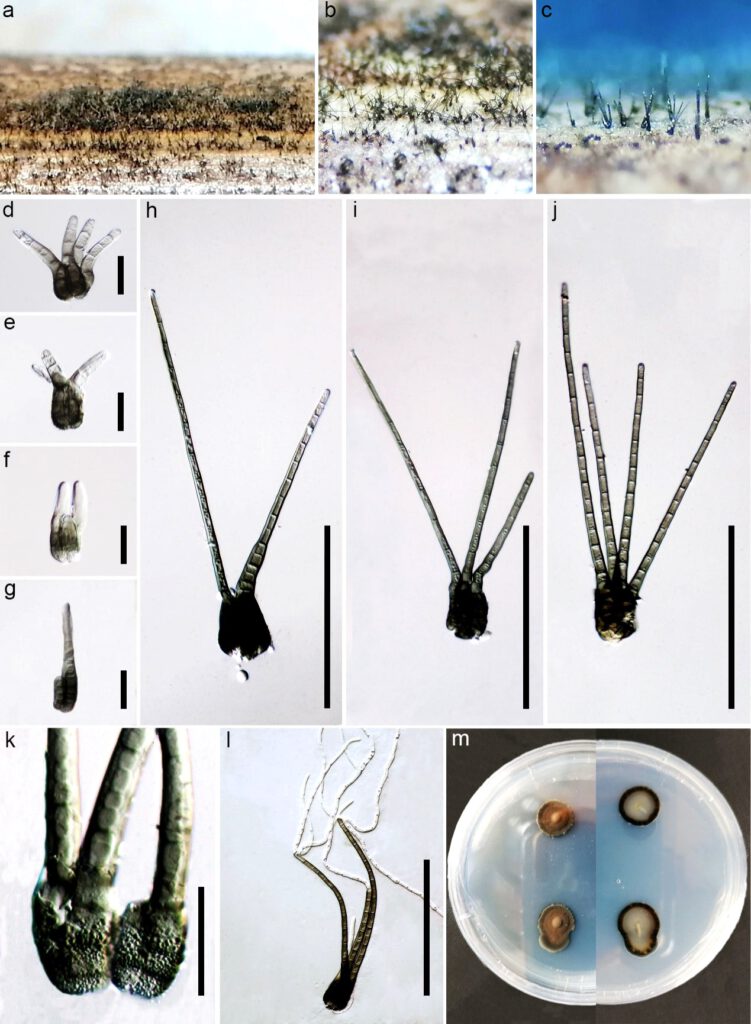Tetraploa dashaoensis C.F. Liao & Doilom sp. nov.
MycoBank number: MB 559273; Index Fungorum number: IF 559273; Facesoffungi number: FoF 10585;
Etymology: Referring to village name of dashao village.
Holotype: KUMCC 21-0010
Saprobic on dead stem of Saccharum arundinaceum, light green to dark green. Sexual morph: undetermined. Asexual morph: hyphomycetous. Colonies superficial, effuse, gregarious, brown to dark green. Mycelium partly immersed in natural substratum, brunched, septate, hyaline. Conidiophores absent. Conidiogenous cells micronematous, integrated, monoblastic, intercalary, short cylindrical. Conidia 25–43 × 13–36 µm ( = 31 × 23 µm, n = 30), solitary, straight, septate, unbranched, composed of 1-4 columns at the base, common mostly young conidia have smooth welled, and grow mature will become verrucose, each column have 1–3-septate, with 1-4 apical appendages. Appendage usually three or four in number rarely one or two, 148–258 µm ( = 186 µm, n = 30), for young appendage is shortly 21–81 µm ( = 43 µm, n = 30), 6–15 µm wide dark green at the base, 3–8 µm wide almost hyaline at the apex, 1–5-septate with young appendage, 6–23-septate with mature appendage, smooth, septate, straight or rarely one is all appendage bristles bend Intertwined.
Culture characteristics: conidia germinating on PDA, germination tube grow from both ends. Colonies on PDA reaching 10 to 14 mm diam, in 17 days at room temperature (25±2˚C), mycelium dense, floccose, surface smooth, velutinous spot center with flat substrate, light brown center spot raise to yellow brown, and dark brown towards to white margin. Colony margin circle or irregular. Colony reverse white at center dark brown towards margin. No pigments production.
Material examined: China, Yunnan Province, Kunming City, from dead grass under Saccharum arundinaceum (Gramineae), 4 July 2020, C.F. Liao, (KUN–HKAS 107636, holotype), ex-type culture KUMCC 21-0010.
Genbank number: ITS: ######, LSU: ######, SSU: ######, BT: #####, TEF1-α: #####
Notes: our new collection KUMCC 21-0010 clusters with strain of Tetraploa aquatica (MFLU 19-0995) (81% ML, 0.98 BYPP; Fig. ###) with high bootstrap support (Fig.##). KUMCC 21-0010 is similar to Tetraploa aquatica (MFLU 19-0995) in having serval longer appendages, cylindrical Conidiogenous cells, verrucose base conidia body. However, KUMCC 21-0010 differs from holotype Tetraploa aquatica (MFLU 19-0995) in having different conidia color (dark green vs. brown to pale brown), longer conidia (25–43 µm vs. 22.5–27 µm), longer appendages (148–258 µm vs. 98–134) with more septate (6–23-septate vs. 6–10-pseudoseptate). Phylogenetic analysis supports them to be different species (Fig. ###). Thus, in this study, we introduce T. dashaoensis as a new species based on morphology and phylogeny.

Fig. ### Phylogram generated from parsimony analysis based on combined LSU, SSU, ITS, β-tubulin and TEF1-α sequence data of Tetraploa. Parsimony bootstrap support values greater than 75% are indicated above or below the nodes, and branches with Bayesian posterior probabilities greater than 0.95 are given at the nodes. The ex-types (reference strains) are in bold; the new isolates are in blue. The tree is rooted with Muritestudina chiangraiensis (MFLUCC 17-2551).

Fig. ### Tetraploa ##### (KUN–HKAS 107636, holotype). a–c. Conidia on host substrate; d–j. Conidia; k. Verrucose conidia; l. Germinating conidium; m. Colony on PDA (left-front, right-reverse); Scale bars: d–g, k = 50 μm, h-j, l = 200 μm.
